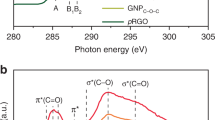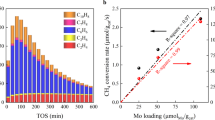Abstract
The one-step transformation of C7–C12 linear alkanes into more valuable oxygenates provides heterogeneous catalysis with a major challenge. In evaluating the potential of a classic mixed-metal-oxide catalyst, we demonstrate new insights into the reactivity of adsorbed oxygen species. During the aerobic gas-phase conversion of n-decane over iron molybdate, the product distribution correlates with the condition of the catalyst. Selectivity to oxygenated aromatics peaks at 350 °C while the catalyst is in a fully oxidized state, whereas decene and aromatic hydrocarbons dominate at higher temperatures. The high-temperature performance is consistent with an underlying redox mechanism in which lattice oxide ions abstract hydrogen from decane. At lower temperatures, the formation of oxygenated aromatics competes with the formation of CO2, implying that electrophilic adsorbed oxygen is involved in both reactions. We suggest, therefore, that so-called non-selective oxygen is capable of insertion into carbon-rich surface intermediates to generate aromatic partial oxidation products.
This is a preview of subscription content, access via your institution
Access options
Subscribe to this journal
Receive 12 print issues and online access
$259.00 per year
only $21.58 per issue
Buy this article
- Purchase on Springer Link
- Instant access to full article PDF
Prices may be subject to local taxes which are calculated during checkout




Similar content being viewed by others
References
Weissermel, K. & Arpe, H-J. Industrial Organic Chemistry (Wiley-VCH, 2003).
Bhasin, M. M., McCain, J. H., Vora, B. V. & Imai, T. Dehydrogenation and oxydehydrogenation of paraffins to olefins. Appl. Catal. A 221, 397–419 (2001).
Satterfield, C. N. Heterogeneous Catalysis in Industrial Practice 2nd edn, Ch. 8 (McGraw-Hill, 1991)
Soon, Y-S., Fujikawa, N., Ueda, W., Moro-oka, Y. & Lee, K-W. Propane oxidation over various metal molybdate catalysts. Catal. Today 24, 327–333 (1995).
Wang, L. et al. Preparation, characterization and properties of ferric molybdate nanotubes for propene epoxidation by air. Chin. J. Catal. 30, 711–713 (2009).
Weng, L-T. & Delmon, B. Phase cooperation and remote control effects in selective oxidation catalysts. Appl. Catal. A 81, 141–213 (1992).
House, M. P., Shannon, M. D. & Bowker, M. Surface segregation in iron molybdate catalysts. Catal. Lett. 122, 210–213 (2008).
Stern, D. L. & Grasselli, R. K. Reaction network and kinetics of propane oxydehydrogenation over nickel cobalt molybdate. J. Catal. 167, 560–569 (1997).
Godefroy, A., Patience, G. S., Cenni, R. & Dubois, J-L. Regeneration studies of redox catalysts. Chem. Eng. Sci. 65, 261–266 (2010).
Mogensen, M., Sammes, N. M. & Tompsett G. A. Physical, chemical and electrochemical properties of pure and doped ceria. Solid State Ionics 129, 63–94 (2000).
Grzesik, Z., Migdalska, M. & Mrowec, S. Chemical diffusion in non-stoichiometric cuprous oxide. J. Phys. Chem. Solids 69, 928–933 (2008).
Duprez, D. Study of surface reaction mechanisms by 16O/18O and H/D isotopic exchange. Catal. Today 112, 17–22 (2006).
Zanthoff, H. W., Bucholz, S. A., Pantazidis, A. & Mirodatos, C. Selective and non-selective oxygen species determining the product selectivity in the oxidative conversion of propane over vanadium mixed oxide catalysts. Chem. Eng. Sci. 54, 4397–4405 (1999).
Carley, A. F., Davies, P. R. & Roberts, M. W. Oxygen transient states in catalytic oxidation at metal surfaces. Catal. Today 169, 118–124 (2011).
Haber, J. in Fundamental and Applied Catalysis: Surface Chemistry and Catalysis (eds Carley, A. F., Davies, P. R., Hutchings, G. J. & Spencer, M. S.) Ch. 11 (Kluwer Academic/Plenum Publishers, 2002).
Davis, B. H. Alkane dehydrocyclization mechanism. Catal. Today 53, 443–516 (1999).
Usov, Yu. N., Skvortsova, Ye. V. & Klyushnikova, G. G. Conversions of C9–C16 alkanes over aluminium molybdate as catalyst. Neftekhimiya (English trans.) 5, 850–855 (1965).
Sterligov, O. D., Solov'yev, V. M. & Isagulyants, G. V. Study of alumina-platinum-lithium catalysts during dehydrogenation of n-decane using the pulse method. Neftekhimiya (English trans.) 20, 523–529 (1980).
Ahuja, R. et al. Catalytic dehydroaromatization of n-alkanes by pincer-ligated iridium complexes. Nature Chem. 3, 167–171 (2011).
Friedrich, H. B. & Mahomed, A. S. The oxidative dehydrogenation of n-octane to styrene using catalysts derived from hydrotalcite-like precursors. Appl. Catal. A 347, 11–22 (2008).
Elkhalifa, E. A. & Friedrich, H. B. Oxidative dehydrogenation of n-octane using vanadium–magnesium oxide catalysts with different vanadium loadings. Appl. Catal. A 373, 122–131 (2010).
Carley, A. F., Davies, P. R. & Roberts, M. W. Activation of oxygen at metal surfaces. Phil. Trans. R. Soc. A 363, 829–846 (2005).
Rodemerck, U., Kubias, B., Zanthoff, H-W. & Baerns, M. The reaction mechanism of the selective oxidation of butane on (VO)2P2O7 catalysts: the role of oxygen in the reaction chain to maleic anhydride. Appl. Catal. A 153, 203–216 (1997).
Zhang, H., Shen, J. & Ge, X. The reduction behaviour of Fe–Mo–O catalysts studied by temperature-programmed reduction combined with in situ Mossbauer spectroscopy and X-ray diffraction. J. Solid State Chem. 117, 127–135 (1995).
Acknowledgements
The authors thank X. Baucherel and M. Watson (Johnson Matthey) and J. Chetty and C. Dwyer (Sasol) for their support throughout this study, which was sponsored by Johnson Matthey and Sasol.
Author information
Authors and Affiliations
Contributions
G.J.H. directed the study. All authors contributed to the planning and interpretation of the experimental work, which was carried out by S.P., M.P.H., A.F.C., M.C., R.L.J. and R.L. The manuscript was drafted by S.P., J.K.B., D.B., A.F.C., S.G. and G.J.H., with input from all authors.
Corresponding author
Ethics declarations
Competing interests
The authors declare no competing financial interests.
Supplementary information
Supplementary information
Supplementary information (PDF 1075 kb)
Rights and permissions
About this article
Cite this article
Pradhan, S., Bartley, J., Bethell, D. et al. Non-lattice surface oxygen species implicated in the catalytic partial oxidation of decane to oxygenated aromatics. Nature Chem 4, 134–139 (2012). https://doi.org/10.1038/nchem.1245
Received:
Accepted:
Published:
Issue Date:
DOI: https://doi.org/10.1038/nchem.1245
This article is cited by
-
Switching Between Oxidation Types Using Molybdenum Phosphate Catalysts for Paraffin Activation Using Doped Fe as Surface Acidity Modifier and MoOx as an Oxygen Insertion Tool
Catalysis Letters (2020)
-
Designing of a New Heterogeneous Polymer Supported Naphthyl-Azo Iron Catalyst for the Selective Oxidation of Substituted Methyl Benzenes
Journal of Inorganic and Organometallic Polymers and Materials (2018)
-
Effect of different weight loadings of MoO x /SBA-15 on the oxidative dehydrogenation of n-octane
Journal of Porous Materials (2015)
-
Effect of the Support on the Oxidation of Heptane Using Vanadium Supported on Alkaline Earth Metal Hydroxyapatites
Catalysis Letters (2015)



